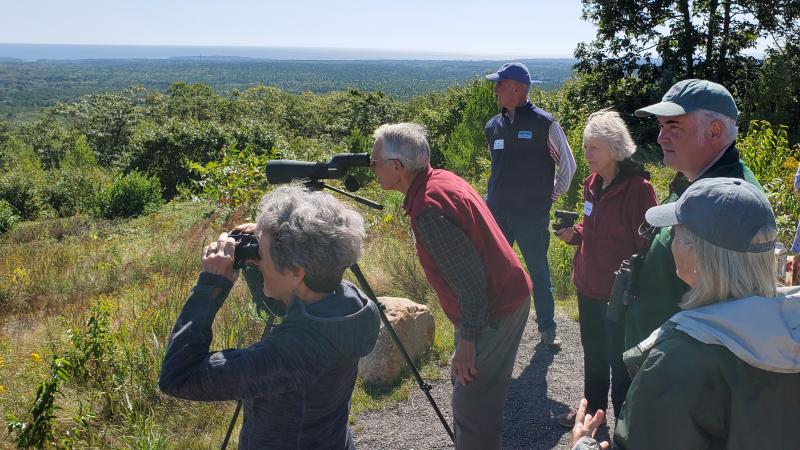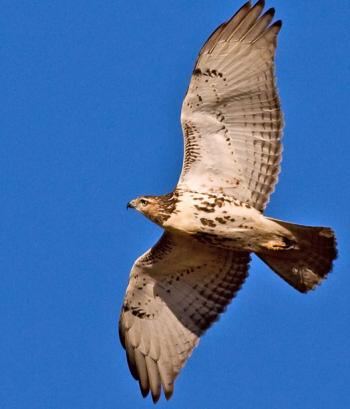We had the good fortune to spend a little time in early September on top of Mt. Agamenticus down in York, Maine, leading a hawkwatching outing for members of the Natural Resources Council of Maine (NRCM). For those of you who have not yet have visited “Mt. A,” as it’s often affectionately referred to as, the mountaintop hosts a town-owned-and-operated nature center that was formerly a small ski lodge. A well-maintained road provides easy access to the summit (hiking enthusiasts can enjoy trails leading up from the base), and there are ample parking locations and multiple viewing platforms from which to enjoy stunning views. The mountaintop panoramic scenes extend eastward to the mountains of New Hampshire and western Maine and eastward to the vast ocean and Maine coastline.
Today, hawkwatching is a pursuit of many birders during the fall when there are sometimes large numbers of hawks migrating south. Not so many years ago, though, fall was considered a time for shooting large numbers of hawks. In fact, two of the most famous hawk-watching spots in the world—Hawk Mountain in Pennsylvania and Cape May in New Jersey—were sights of some of the worst annual hawk slaughters. Hawk Mountain became a bird conservation flashpoint when ornithologist Richard Pough published photos showing literally piles of dead hawks killed at Hawk Mountain in the early 1930s. A conservation activist named Rosalie Edge saw the photos and in 1934 leased the land and hired a warden which effectively ended the killing at that location. Roger Tory Peterson recounted being at Cape May in the 1930s and watching as gunners killed hundreds of sharp-shinned hawks trying to cross an open area. And that was nothing compared to the 1,400 hawks killed in a single day there in 1920!
Fortunately, attitudes and laws changed. Now, both Cape May and Hawk Mountain are famous meccas for hawkwatching, hosting thousands of visitors annually.
Mt. Agamenticus was never a place where hawks were killed in migration, but it has been a popular spot for hawkwatching for decades. We well remember our old friends, Rena Cote and June Ficker, both now passed on, who ensured that the hawks were diligently counted each fall for many years from the summit of Mt. Agamenticus.
On the September day of our NRCM event, we were just hoping to see a few hawks to show some friends and visitors. Good hawkwatching depends on the date and the weather. We had a beautiful, clear day but with only light winds (hawks like some wind to keep them in the air and moving south). We hoped we might see decent numbers of broad-winged hawks, which tend to peak in migratory numbers in September. We did indeed see a few broad-winged hawks, but at a distance that made it hard for some of our friends to see well.
What we did see well were several red-tailed hawks. Red-tails, as they are affectionally called by most birders, are one of the most common hawks across North America. They are adaptable and can be found along highways, in overgrown fields, and even right in cities. The red-tailed hawks of Central Park in New York City have become quite famous (there’s at least one book written about them) and the famous great black hawk of Portland was regularly harassed by the many city red-tailed hawks resident there.
The height of red-tailed hawk migration here in Maine is in October, so we were a little early to be seeing migrant red-tails on our September visit to Mt. Agamenticus. But we were blessed when a gorgeous red-tailed hawk—likely one of the local resident birds that had nested nearby—swooped in and landed a hundred yards away. The show got even better when it dropped down into the brush, grabbed a snake, and ate it while we all got great views through the telescope!
We sure are glad things have changed from those hawk-killing days of a century ago.
Jeffrey V. Wells, Ph.D., is a Fellow of the Cornell Lab of Ornithology. Dr. Wells is one of the nation's leading bird experts and conservation biologists and author of “Birder’s Conservation Handbook”. His grandfather, the late John Chase, was a columnist for the Boothbay Register for many years. Allison Childs Wells, formerly of the Cornell Lab of Ornithology, is a senior director at the Natural Resources Council of Maine, a nonprofit membership organization working statewide to protect the nature of Maine. Both are widely published natural history writers and are the authors of the book, “Maine’s Favorite Birds” and “Birds of Aruba, Bonaire, and Curaçao: A Site and Field Guide” from Cornell Press.
































